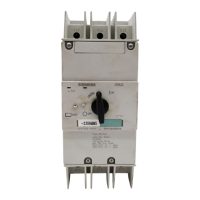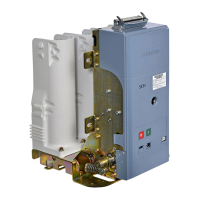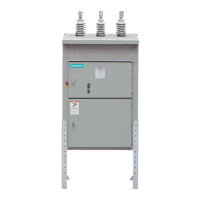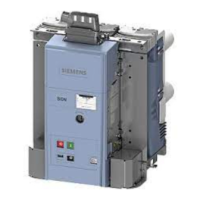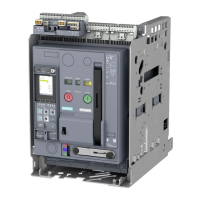Metering
and
Extended
Protective Relaying
U
Fundamental
Conf
i
guration
Parameters
The
parameters
described
in
this
paragraph
must be set for
proper
operation
of the trip unit.
They affect fundamental
communications and metering functions. Parameters that
must
be set
for
a
given
trip unit model are indicated
with
a
(+)
in
the
following
table.
Fundamental
Conf
iguration Parameters
Address
-
The Address
must be set
for
all communicating
model
types.
Valid
ranges are
1
through
224.fheIrip
units
are
shipped
from
stock at address
222. llis recommended that
only addresses 1
through
221
be used
in an installation, Each
trip unit connected on the same network must
have
a unique
address.
The
address 222 is also suggested as the
"parking"
address of any
trip unit taken out of service.
Baud Rate
-
Alltrip
units connected on the same
network must
have
the same baud
rate. Valid
selections
for Baud Rate are
2,4OO,4,800, and
9 600 baud.
The
trip
units are shipped from
the
factory set for 4,800
baud.
Phase Sensor Rating
-
The Phase Sensor
rating
(or
I
SCALE)
must
be set equal to the
primary
ampere
rating
of the
current
sensor
on the
circuit breaker
in which the trip unit is installed.
Example: lf the current sensor is rated at 800 Amps
(800/0
5)
then 800
would
be the value used
for
the
Phase
Sensor
Rating,
This number
affects the
values
displayed
for the metered
currents
la, lb, lc
and
ln
(if
ordered). On CP
models it also
affects the values displayed for kW, kVA,
kVAR kWH kVARH
kWHR, and kWD, lt also affects the operation of any current
or
power
based alarm
and
relaying functions. The normal
range
of the Phase Sensor Rating is 80 to 4,000.
Ground Sensor
Rating
-
The
Ground
Sensor rating
(or
G
SCALE)
must
be set equal to the
primary
ampere
rating
of
the
ground
sensor used by the circuit breaker
for
ground
fault
sensing. Example: lf
the
ground
sensor
is rated at 800 Amps
(800/0
5) then 800 would be the value used for the Ground
Sensor
Rating. This number
affects the
values
displayed
for
the metered current lg. lt also affects the operation of the
ground
current based alarm function.
Phase Rotation
-
The Phase Rotation must
be set
to the
phasing
of the system in which the circuit breaker is installed.
It may be set to ABC
(normal phasing)
or ACB
(inverted
phasing)
The
setting affects
values displayed
for the
voltages,
kW, kVAR, kWH kWHR, kVARH and
kWD, It also affects
the
operation
of any voltage or
power
based
relaying
functions.
Volts
Source
-
The Volts
Source
is settable to
Top or Bottom.
It
should be set
to Top if the
powei
source
is fed
into
the
top of
the circuit
breaker; Bottom
if
the
power
source
is fed into the
bottom. This setting affects
the displayed sign
of the kW and
kVAR
readings. lt
also
affects the accumulated
values
for kWH,
kWHR
kVARH
and
kWD and the operation
of any associated
alarm and
relay functions.
Volts
Scale
-
The Volts Scale
is normally set to the
nominal
line-
line voltage
(2O8,
240,380 480 or 600) of
the system
The
value is
used only
by the voltage unbalance
alarm and
relay
functions. lt does
not
affect the
displayed
voltage values.
Volts
Mode
-
The Volts Mode is settable
to 3-Wire or
4-Wire.
Use 3-Wire
when there is no
neutral connection
in
the
system;
otherwise,
use 4-Wire. In 3-Wire
mode,
phase
to
neutral
voltages will not be
measured or displayed.
kW
Demand Period Length and
Number
of
Periods
-
De-
mand Period Length is settable
from I to 99
minutes. Number
(of
)
Periods is settable
f rom 1
to
15. This allows
for f ixed interval
or sliding window
methods of demand calculation.
For the
fixed
interval,
set the
Length to the desired
time and
set
the
Number
of
Periods to 1 . For the sliding
window
method, set
the
Length and the Number of
Periods such that
their
pro-
duct equals the desired demand
interval.
Comm
Trip
-
The Comm
Trip is
settable
to either On
or Off
. All
communications trip units are
capable of tripping
the circuit
breaker via a series of commands
from a
master device
us-
ing the RS-485 bus. Comm
Trip must be
set to On
for the
command sequence
to be recognized
and a trip to
occur.
Remote tripping of the circuit breaker
is stored
in
the
trip unit's
event
log. The Comm
Trip
setting
does not affect
the operation
of any of the trip unit's
protection
functions, neither the
basic
nor
the extended
functions.
Comm
Close
-
The
Comm
Close
is
settable
to either On
or Off .
All communications
trip units are capable
of closing the
circuit
breaker
via a series of commands
from a master device
using
the RS-485 bus. Comm Close
must be
set to On
for the
command sequence
to be recognized
and a closure
to
occur.
Remote closing of the circuit
breaker
is
stored
in the
trip unit's event log.
A
special
Anti-Pump
"Y"
Relay is used to
integrate the Output
2
(close
breaker) signal
into electrically
operated
Type RL breaker
wiring
(see
Instruction
Manual
SG3068
for details),
Comm Open
-
The
Comm Open
is settable to
either On or Off
.
When used with the appropriate
interposing
relay, communi-
cations trip units are capable
of opening an
electrically oper-
ated circuit
breaker via a series of commands
from a
master
device
using the RS-485 bus. Comm
Open
must be set to On
for the command sequence
to be recognized
and an opening
to occur,
Remote
opening
of the circuit breaker
is stored
in
the
trip unit's
event log.
Parameler
Trip
Unit
Model
iltc/cN iltcP/cNP/cPx/cNPx
AOO rESS
Baud Rate
Phase Sensor Ratrng
Ground Sensor Rating
+
+
+
+
+
+
+
+
Phase Fotation
Volts Source
Volts Scale
Voits lvlode
Demand Per od Length
Number of Periods
+
+
+
+
+
+
Cornm
Tr
p
Comm C ose
Comm Open
t
+
+
+
+
+
rb/
27

